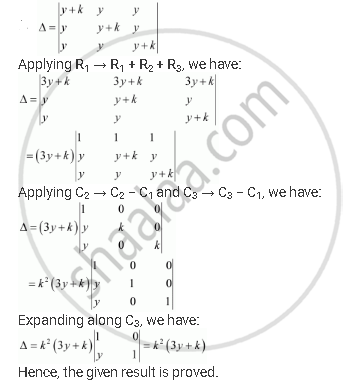Advertisements
Advertisements
Question
By using properties of determinants, show that:
`|(y+k,y, y),(y, y+k, y),(y, y, y+k)| = k^2(3y + k)`
Solution

APPEARS IN
RELATED QUESTIONS
Using properties of determinants, show that ΔABC is isosceles if:`|[1,1,1],[1+cosA,1+cosB,1+cosC],[cos^2A+cosA,cos^B+cosB,cos^2C+cosC]|=0`
Using properties of determinants, prove that
`|[x+y,x,x],[5x+4y,4x,2x],[10x+8y,8x,3x]|=x^3`
By using properties of determinants, show that:
`|(0,a, -b),(-a,0, -c),(b, c,0)| = 0`
By using properties of determinants, show that:
`|(1,1,1),(a,b,c),(a^3, b^3,c^3)|` = (a-b)(b-c)(c-a)(a+b+c)
Using properties of determinants, prove that:
`|(1, 1+p, 1+p+q),(2, 3+2p, 4+3p+2q),(3,6+3p,10+6p+3q)| = 1`
Using properties of determinants, prove that
`|(sin alpha, cos alpha, cos(alpha+ delta)),(sin beta, cos beta, cos (beta + delta)),(sin gamma, cos gamma, cos (gamma+ delta))| = 0`
Using properties of determinants, prove that
`|(a^2 + 2a,2a + 1,1),(2a+1,a+2, 1),(3, 3, 1)| = (a - 1)^3`
Using properties of determinants, prove that:
`|(1+a^2-b^2, 2ab, -2b),(2ab, 1-a^2+b^2, 2a),(2b, -2a, 1-a^2-b^2)| = (1 + a^2 + b^2)^3`
Using properties of determinants, prove the following :
Prove the following using properties of determinants :
\[\begin{vmatrix}a + b + 2c & a & b \\ c & b + c + 2a & b \\ c & a & c + a + 2b\end{vmatrix} = 2\left( a + b + c \right) {}^3\]
Using properties of determinants, prove that
`|[b+c , a ,a ] ,[ b , a+c, b ] ,[c , c, a+b ]|` = 4abc
Using properties of determinant show that
`|("a" + "b", "a", "b"),("a", "a" + "c", "c"),("b", "c", "b" + "c")|` = 4abc
Using properties of determinant show that
`|(1, log_x y, log_x z),(log_y x, 1, log_y z),(log_z x, log_z y, 1)|` = 0
Select the correct option from the given alternatives:
If x = –9 is a root of `|(x, 3, 7),(2, x, 2),(7, 6, x)|` = 0 has other two roots are
Answer the following question:
Evaluate `|(101, 102, 103),(106, 107, 108),(1, 2, 3)|` by using properties
Answer the following question:
Without expanding determinant show that
`|(0, "a", "b"),(-"a", 0, "c"),(-"b", -"c", 0)|` = 0
Evaluate: `|(3x, -x + y, -x + z),(x - y, 3y, z - y),(x - z, y - z, 3z)|`
Evaluate: `|("a" - "b" - "c", 2"a", 2"a"),(2"b", "b" - "c" - "a", 2"b"),(2"c", 2"c", "c" - "a" - "b")|`
Prove that: `|(y + z, z, y),(z, z + x, x),(y, x, x + y)|` = 4xyz
The determinant `abs (("a","bc","a"("b + c")),("b","ac","b"("c + a")),("c","ab","c"("a + b"))) =` ____________
If `abs ((2"x",5),(8, "x")) = abs ((6,-2),(7,3)),` then the value of x is ____________.
The value of the determinant `abs ((alpha, beta, gamma),(alpha^2, beta^2, gamma^2),(beta + gamma, gamma + alpha, alpha + beta)) =` ____________.
If the ratio of the H.M. and GM. between two numbers a and bis 4 : 5, then a: b is
A system of linear equations represented in matrix form Ax = 0, A is n × n matrix, has a non-zero solution if the determinant of A (i.e., det(A)) is
In a third order matrix B, bij denotes the element in the ith row and jth column. If
bij = 0 for i = j
= 1 for > j
= – 1 for i < j
Then the matrix is
`f : {1, 2, 3) -> {4, 5}` is not a function, if it is defined by which of the following?
The A.M., H.M. and G.M. between two numbers are `144/15`, 15 and 12, but not necessarily in this order then, H.M., G.M. and A.M. respectively are
Which of the following is correct?
In a triangle the length of the two larger sides are 10 and 9, respectively. If the angles are in A.P., then the length of the third side can be ______.
Without expanding determinants find the value of `|(10,57,107),(12,64,124),(15,78,153)|`
By using properties of determinant prove that `|(x+y,y+z,z+x),(z,x,y),(1,1,1)|` = 0
Without expanding evaluate the following determinant:
`|(1, a, b + c), (1, b, c + a), (1, c, a + b)|`
By using properties of determinant prove that
`|(x+y,y+z,z+x),(z,x,y),(1,1,1)|=0`
Without expanding evaluate the following determinant.
`|(1,"a","b+c"),(1,"b","c+a"),(1,"c","a+b")|`
